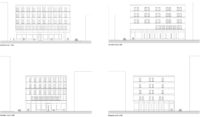16 July 2018 – This spring I had the privilege to tutor two groups of architecture students from Vaduz (Liechtenstein) and Rotterdam (The Netherlands). In the design course we focussed on the urban building type of the Florentine palazzo as developed in the renaissance. The courses build on the typological study undertaken by Karin Templin with students of the Department of Architecture at the University of Cambridge 2013-14
Introducing both design studios, I expressed two wishes for my students. First, that they would lose some of their fear of history. Second, that they would lose their fear for construction practice. Architects’ practice and teaching have distanced itself from both territories to a problematic degree. But isn’t it construction is what makes architecture happen in the first place? And doesn’t the history of any profession provide the reservoir of knowledge, skill and technique for current practice? Why should that be so different in the discourse and the education of architects?
Therefore, the Florentine palazzo was studied as a strictly physical phenomenon. For a moment, we left the stories for what they were. The palazzo was not taken as a historical concept to be studied clinically, at arm’s length. Rather, the structures of the palazzo were studied and drawn. We found out that the palazzo used to be fabricated of rubble walls and vaults. The stonework of the corniches, corners and rusticas, contributing so much to the monumental urban imagery, appeared to be a relatively thin layer of cladding. The spatial organization of the palazzo was represented in isometric drawings in which type, geometry and urban imagery were made clear in glance.
Overlooking the results of their analysis of six centuries of palazzo building, it becomes clear that, no matter how rational the method of analysis is, the findings and ways of representing these differ considerably, just like the palazzo type has provided for considerable architectural variability. One might take this as a hint to keep perpetually studying the architectural canon, hoping for slow, incremental progress in building up an understanding of it.
The design of a range of new palazzi departed from a similar matter-of-factness. The brief called for a flexible housing block with public amenities at ground floor. Because that is what a palazzo also is: a solid piece of architecture that has resisted time and sometimes brutal changes in use. And again the results reveal remarkable differences in approach.
Florian Heeb, a second year bachelor student in Vaduz, designed a compact housing block with an a-symmetric court. This move introduced different widths in the four wings of the building, which ultimately resulted in differentiations between the four facades. The casual civic tectonics may remind one of a post office from the 1950-ies, calm and monumental through its understandable imagery.
Nothing could be further away from this design than the proposal of Karel van Zanten, a first year master student in Rotterdam. He boldly stacked two prominent Florentine types on one another, a tower upon a palazzo. Inspired by the graffiti facades in the city, the facades of these buildings are to be cladded with stone tiles. An giant building is made tactile by the fragility of its skin.
The most suggestive product of both studios is the tiny street section which was made by Lisa van der Slot. The section is taken over Palazzo Strozzi, the largest and arguably the most impressive palazzo of Florence. The proposed new palazzo stands up to the size of Strozzi. Current domestic requirements were reason for several innovations of its typology and its material manifestation. With a strong hand an equivalent of the famous EUR palazzo in Rome was developed. Yet, the building is not represented as masculine. The street section merely shows the corner of the new building and suggests how the proposed gallery matches the front line of Strozzi and how the different urban scales are reconciled. The Florentine palazzo seems to be understood as real, solid and urban. Perhaps it is no surprise that the author of this piece of work is a third year master student in urban design in Rotterdam.
It is encouraging that the students, and that is by no means restricted to the three mentioned above, have worked with history and with construction – rather than to have worked against it.
The analysis and design work has been compiled in an A3 book which can be downloaded here (62 MB).



